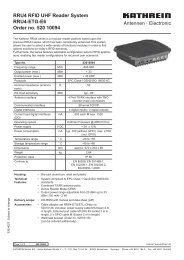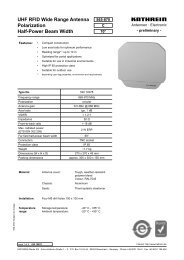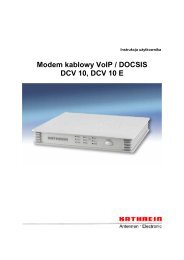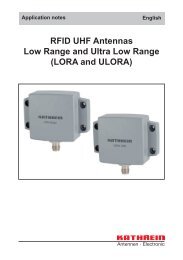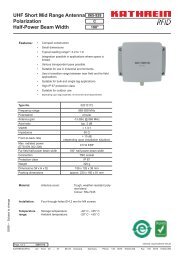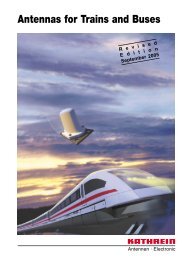Basic Antenna Principles for Mobile Communications
Basic Antenna Principles for Mobile Communications
Basic Antenna Principles for Mobile Communications
You also want an ePaper? Increase the reach of your titles
YUMPU automatically turns print PDFs into web optimized ePapers that Google loves.
3. Definitions<br />
3.1 Polarization<br />
Polarization can be defined as the direction of oscillation of the electrical field vector.<br />
<strong>Mobile</strong> communications: vertical polarization<br />
Broadcast systems: horizontal polarization<br />
3.2 Propagation Pattern<br />
In most cases the propagation characteristic of an antenna can be described via elevations through the<br />
horizontal and vertical radiation diagrams. In mobile communications this is defined by the magnetic<br />
field components (H-plane) and the electrical field components (E-plane). Very often a 3-dimensional<br />
description is chosen to describe a complex antenna.<br />
3.3 Half-Power-Beam-Width<br />
This term defines the aperture of the antenna. The HPBW is defined by the points in the horizontal and<br />
vertical diagram, which show where the radiated power has reached half the amplitude of the main<br />
radiation direction. These points are also called 3 dB points.<br />
3.4 Gain<br />
In reality one does not achieve an increment in energy via antenna gain. An antenna without gain radiates<br />
energy in every direction. An antenna with gain concentrates the energy in a defined angle segment<br />
of 3-dimensional space. The λ/2-dipole is used as a reference <strong>for</strong> defining gain. At higher frequencies<br />
the gain is often defined with reference to the isotropic radiator. The isotropic radiator is an non-existant<br />
ideal antenna, which has also an omnidirectional radiation characteristc in the E-plane and H-plane.<br />
Calculation:<br />
Gain (with reference to the isotropic radiator dBi) = Gain (with reference to λ/2-Dipole dBd) + 2.15 dB<br />
The gain of an antenna is linked to the radiation characteristic of the antenna. The gain can be roughly<br />
calculated by checking the HPBW`s in the horizontal and vertical planes (Fig.6).<br />
– 5 –





